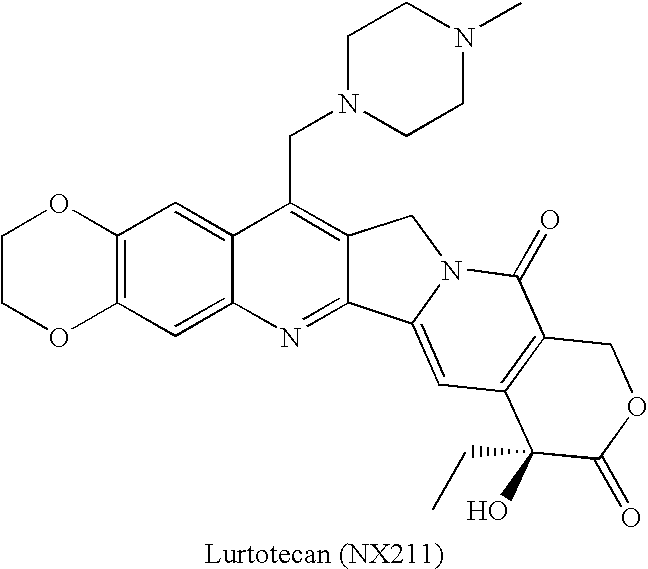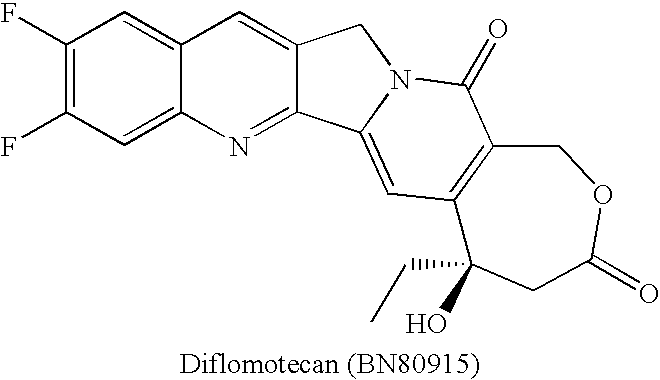Camptothecin-analog with a novel, "flipped" lactone-stable, E-ring and methods for making and using same
a technology of lactonestable and camptothecin, which is applied in the field of lactonestable, lactonestable, and analogs, can solve the problems of unmanageable drugs, high disappointment in clinical trials performed using sodium hydroxide-formulated cpt, and many deleterious physiological side effects associated with their use, and achieves the effect of beneficial chemotherapeutic effects
- Summary
- Abstract
- Description
- Claims
- Application Information
AI Technical Summary
Benefits of technology
Problems solved by technology
Method used
Image
Examples
example i
[0294]For injection or infusion into aqueous body fluids, a formulation comprises a total dose of from approximately 0.1 mg / m2 to approximately 100 mg / m2 of the novel, lactone-stable, “flipped” E-ring camptothecin dissolved in 1 to 10 parts of N-methylpyrrolidinone, dimethylisosorbide and / or dimethylacetamide in an acidified vehicle comprising between approximately 10 to approximately 40 percent of an acceptable alcohol, approximately 4 to approximately 10 parts by weight of polyether glycol, and approximately 1 to approximately 10 parts of a non-ionic surfactant. Suitable alcohols include dehydrated ethyl alcohol, benzyl alcohol. Suitable polyether glycols, include polyethylene glycol 200, polyethylene glycol 300, propylene glycol. Suitable non-ionic surfactants include, but are not limited to, polysorbate-80. In a preferred embodiment, the formulation of the novel, lactone-stable, “flipped” E-ring camptothecin is supplied as an intravenous injectable in a 1 mg vial comprising a st...
example ii
[0295]A second formulation comprises a total dose of from approximately 0.1 mg / m2 to approximately 100 mg / m2 of the novel, lactone-stable, “flipped” E-ring camptothecin in an acidified vehicle comprising between approximately 0.1 to 2 parts of an alcohol and approximately 1 to 10 parts of a non-ionic surfactant. Suitable alcohols include dehydrated ethyl alcohol USP, and benzyl alcohol. Suitable non-ionic surfactants include the polyoxyethylated oils, such as polyoxyethylated vegetable oils, such as castor oil, peanut oil, and olive oil. In a preferred embodiment 1 mg to 200 mg the novel, lactone-stable, “flipped” E-ring camptothecin is formulated in 1 to 10 parts of N-methylpyrrolidinone, dimethylisosorbide and / or dimethylacetamide, 1 to 10 parts of Cremaphor EL™ (polyoxyethylated castor oil), 0.1 to 2 parts by weight dehydrated ethyl alcohol USP, and 0.1 to 0.9 parts citric acid to adjust the final pH between 3 to 4.
example iii
[0296]An oral formulation of the novel, lactone-stable, “flipped”“flipped” E-ring camptothecin in soft gelatin capsules (e.g., comprised of gelatin / glycerin / sorbitol / purifiers) containing 1.0 part of the novel, lactone-stable, “flipped” E-ring camptothecin in 1 to 10 parts of N-methylpyrrolidinone, dimethylisosorbide and / or dimethylacetamide, citric acid 0.1 to 0.5 parts by weight, glycerin 1 to 10 parts by weight, and polyethylene glycol 200 to 300 5 to 9 parts by weight, dehydrated ethyl alcohol 0.2 to 2 parts by weight of total solution weight, sodium acetate 0.05 to 0.5 parts by weight, pluronic poloxamer using 0.05 to 1.0 parts by weight, and taurocholic acid 2 to 10 parts by weight. The soft gelatin capsules may also be composed of any of a number of compounds used for this purpose including, for example, a mixture of gelatin, glycerin, sorbitol, and parabens.
[0297]It should be noted that in order to prolong the stability and solubility of the novel, lactone-stable, “flipped” ...
PUM
| Property | Measurement | Unit |
|---|---|---|
| Fraction | aaaaa | aaaaa |
| Fraction | aaaaa | aaaaa |
| Fraction | aaaaa | aaaaa |
Abstract
Description
Claims
Application Information
 Login to View More
Login to View More - R&D
- Intellectual Property
- Life Sciences
- Materials
- Tech Scout
- Unparalleled Data Quality
- Higher Quality Content
- 60% Fewer Hallucinations
Browse by: Latest US Patents, China's latest patents, Technical Efficacy Thesaurus, Application Domain, Technology Topic, Popular Technical Reports.
© 2025 PatSnap. All rights reserved.Legal|Privacy policy|Modern Slavery Act Transparency Statement|Sitemap|About US| Contact US: help@patsnap.com



